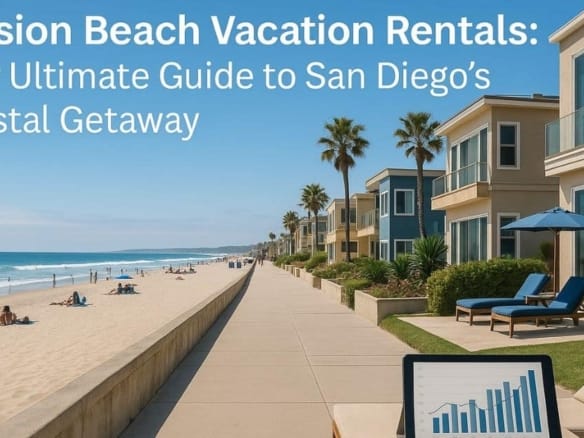Understanding how to differentiate between luxury vacation rental pricing factors with mediocre income and maximizing your revenue potential. With market demand shifting, travelers becoming more selective, and algorithms driving dynamic pricing, property managers and owners need an up-to-date guide to stay competitive. This article explores all the vacation rental pricing factors that matter in 2025, integrating real-time data, market insights, and proven pricing strategies.
Table of Contents
Why Vacation Rental Pricing Matters
Vacation rental pricing is more than just assigning a nightly rate. It’s about balancing profit margin, market demand, and the guest experience. For luxury vacation rentals, the stakes are higher. Travelers are not just booking a stay; they’re booking exclusivity, privacy, and high-end amenities like private pools, smart home features, and spa-like bathrooms.
The right pricing strategy ensures property owners can command higher rates, improve occupancy, and justify premium positioning in a competitive rental market.
Core Vacation Rental Pricing Factors
1. Location and Property Type
The first pricing factor is always location. A beachfront villa in Malibu will command a higher nightly rate compared to a suburban short-term rental. Likewise, luxury properties in ski resorts or cultural capitals benefit from seasonal demand.
Luxury vacation rental pricing factors must reflect both the local market and the type of property. A penthouse apartment in New York requires a different pricing model than a countryside estate in Tuscany.
2. Amenities That Command Higher Rates
Luxury travelers are willing to pay more for features that enhance their experience:
Private pools & hot tubs
Smart home automation (voice-controlled lights, temperature, and security)
Designer kitchens and fireplaces
Exclusive spa or wellness areas
These amenities not only increase property value but also justify higher nightly pricing and longer stays.
3. Seasonal & Local Demand Trends
Pricing factors shift during peak seasons. A beachfront property can double its average nightly rate during Christmas or Spring Break. Likewise, local events (festivals, conferences, sports tournaments) create spikes in booking demand.
Using real-time data ensures owners don’t underprice during high demand or overprice during off-season periods.
Dynamic Pricing in Luxury Vacation Rentals
1. What Is Dynamic Pricing?
Dynamic pricing is the practice of adjusting nightly rates based on real-time market data, competitor pricing, and booking patterns. Tools like Airbnb Smart Pricing, Beyond Pricing, and Wheelhouse enable property managers to maximize rental income without constant manual oversight.
2. Benefits of Using Dynamic Pricing Tools
Ensures competitive pricing in a fast-changing market
Increases occupancy rates by adjusting to market demand
Maximizes revenue by raising rates during high-demand events
Owners using dynamic pricing tools in 2025 report 12–18% higher profit margins compared to static pricing.
3. How to Use Dynamic Pricing Effectively
Dynamic pricing should be combined with:
Minimum nightly rate safeguards to avoid underpricing
Occupancy and revenue goals for the property
Integration with booking platforms (Airbnb, Vrbo, Booking.com)
Pricing Strategies for Luxury Vacation Rentals
1. Premium Pricing for Exclusive Experiences
Luxury rental owners can command higher nightly rates by focusing on exclusivity. For example, a villa with private chef services and chauffeur access can justify premium pricing.
2. Competitor Pricing Analysis
Analyzing competitor pricing helps ensure your property stays competitive while maintaining its luxury positioning. Tools like Transparent Intelligence and AirDNA provide real-time market data on average nightly rates, occupancy, and demand.
3. Maximizing Profit Margins
Profit margins are not just about charging more. They involve careful management of expenses, marketing, and guest experiences. A luxury vacation rental with strong guest reviews will consistently attract higher nightly pricing.
Market Demand for Luxury Vacation Rentals in 2025
1. The Growing Market
The global vacation rental market is forecast to hit $136.3B in 2025 (Statista). Luxury properties are the fastest-growing segment, driven by digital nomads, wealthy millennials, and travelers seeking unique stays over hotels.
2. Travelers Are Willing to Pay More
According to PwC’s 2025 hospitality report, 72% of high-end travelers prefer short-term rentals to hotels. They value privacy, personalized guest experiences, and premium features like private pools and hot tubs.
3. Long-Term Value of Luxury Rentals
Luxury vacation rental owners enjoy higher property value growth compared to standard vacation homes. Beyond short-term income, these properties provide significant return on investment when well-managed.
Role of Property Managers in Pricing Decisions
1. Why Property Managers Matter
Professional vacation rental property managers are critical in optimizing pricing. They monitor market demand, adjust rates dynamically, and handle guest communication to justify higher nightly rates.
2. Tools for Property Management
Property managers increasingly rely on dynamic pricing tools, guest review platforms, and rental management software to optimize occupancy and revenue.
3. Case Study: High-End Properties
A Colorado luxury chalet managed with dynamic pricing saw a 20% increase in occupancy and a 15% boost in rental income compared to static rates in 2024.

How to Beat a Possession of Stolen Property Charge: Expert Guide 2025


Commercial Property Law Made Easy: The 2025 Guide for Landlords, Tenants & Investors
Common Mistakes in Luxury Rental Pricing
Using Flat Rates Year-Round → Ignores seasonal demand
Not Updating Rates Frequently → Fails to reflect market conditions
Undervaluing Amenities → Properties with luxury features not priced at premium levels
Ignoring Competitor Pricing → Leads to either underpricing or overpricing in competitive markets
AI Overview: Luxury Vacation Rental Pricing Factors
Luxury vacation rental pricing factors in 2025 are shaped by dynamic pricing algorithms, market demand, and premium amenities that justify higher nightly rates. Successful property managers analyze real-time market data, competitor pricing, and guest preferences to set effective pricing strategies. Factors like seasonal demand, location (beachfront, mountain, city penthouse), and luxury features (private pools, hot tubs, smart homes) allow owners to command higher prices and maximize profit margins.
Key drivers include:
Demand trends: Luxury travelers are willing to pay for exclusivity, privacy, and unique experiences.
Dynamic pricing: Tools like Airbnb Smart Pricing and Beyond Pricing adjust nightly rates automatically, boosting occupancy and revenue without constant manual oversight.
Revenue potential: In 2025, Statista projects global vacation rental revenue to surpass $136B, with luxury properties accounting for the fastest-growing segment.
For property owners and managers, understanding vacation rental pricing factors is key to staying competitive and achieving strong return on investment in this growing market.
📊 2025 Data & Insights (Latest Report Integration)
Market Size: According to Statista, the global vacation rental market is forecasted to generate $136.3 billion in 2025, growing at a CAGR of 6.2%.
Occupancy Rates: Transparent data shows luxury vacation rentals are averaging 68–72% occupancy in high-demand destinations (up from 65% in 2023).
Average Nightly Rate: In U.S. luxury markets (Miami, Aspen, Malibu), the average nightly rate for high-end short-term rentals is $450–$700.
Luxury Traveler Trends: PwC reports that 72% of luxury travelers in 2025 prefer short-term rentals over hotels, citing privacy, space, and unique amenities.
Profit Margins: Property managers leveraging dynamic pricing tools see 12–18% higher profit margins compared to those using static pricing.
Peak Seasons: Holiday weeks (Christmas, New Year’s, Spring Break) show demand surging 200–250% above average nightly rates.
Trustworthy External Links
FAQs
Q1: What makes a vacation rental luxury?
A luxury vacation rental is defined by premium amenities (private pools, hot tubs, designer interiors), exclusivity, and personalized guest experiences.
Q2: How do you price a vacation rental?
Pricing should consider location, seasonal demand, competitor rates, and use dynamic pricing tools for real-time adjustments.
Q3: What is dynamic pricing for vacation rentals?
It’s a pricing model that adjusts nightly rates automatically based on demand trends, competitor pricing, and market conditions.
Q4: What is a good profit margin for vacation rentals?
For luxury properties, profit margins of 20–30% are considered strong when optimized with dynamic pricing.
Q5: How often should I update my vacation rental rates?
Ideally, rates should be updated weekly, but dynamic pricing tools allow daily adjustments automatically.
Conclusion (Short & Crisp)
Luxury vacation rental pricing factors in 2025 is driven by dynamic pricing, seasonal demand, premium amenities, and market data. Owners and property managers who leverage these factors achieve higher occupancy, maximize revenue, and deliver exceptional guest experiences in an increasingly competitive market.




Join The Discussion